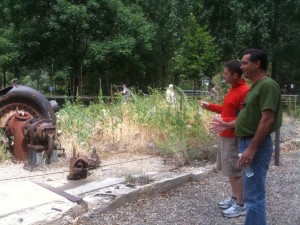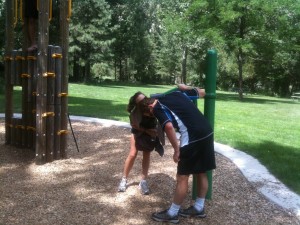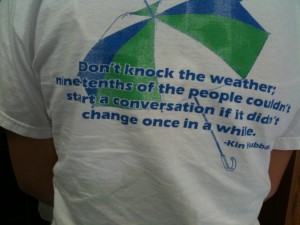
Ben surveys a mile of huge stones carried by a flood
WAS*IS*WILLBE
Boulder, CO
Connecting the Dots
Will WAS*IS live?
Touched by the Weather
The continental United States experiences more sudden, severe weather than anyplace else on the globe. This astonishing fact occurs because of geography and patterns of wind. Less surprising but still fascinating is that most of the participants attending WAS*IS (including the social scientists) experienced a major weather event when they were young. Whether or not you believe humans have anything to do with global warming – or even in global warming itself, chances are increasing that you’ve been exposed to or affected by a recent severe weather event. At least, this is an assumption that social scientists can help assess.
- What are the costs of bad weather?
- Do we measure this in purely economic terms, or do we need to also understand the sociocultural implications as people adapt, grow, or fail to learn lessons from surviving a natural hazard?
The water is rising

Kevin and Bob: Doing Something Technical
The point of the Societal Impacts Program is to bring the social into team science:
SIP serves as a focal point for developing and supporting a closer relationship between weather researchers, operational forecasters, relevant end users,
and social scientists.
According to the veterans, some amazing things have happened during this 10th “summer workshop” exploring “what WAS to what IS the future” of integrated social and physical science. The representation of stakeholders at the 2011 WAS*IS is impressive: roughly half of the participants are professors, students and/or professional researchers from social science disciplines, with the other half including four television weathermen, two employees of for-profit business companies, and several National Weather Service employees, ranging from extensively-trained meteorologists and technicians in Weather Forecast Offices to national policy advisors and top-level agency directors.
We are, however, missing representation from the largest set of end-users, the diversity of publics who care about weather news. Social science is needed to identify

Caitlin and Jay, listening carefully.
- the very different reasons and diversity of needs of interested consumers of weather news;
- failures of education and training in making weather knowledge common – widely shared and collectively understood;
- social interactions of time and the timing of warnings with both short-fuse and long-fuse weather hazards (such as flash floods or hurricanes, respectively).
Did you know that the National Weather Service warning for Hurricane Katrina was the most precise and accurate warning in history? Not only did the official warning provide a very long lead time, it also predicted in acute detail the devastation about to occur.
A new line in the sand

Brittany's Emergency Management Support Statement

Brittany's Emergency Management Support Statement
Including so many social scientists in the WAS*IS 2011 Summer Workshop raises the bar for organizers and participants too. The diversity of disciplinary backgrounds means the training model has to embrace new interaction capacities and grow. Just like people in other components of the weather enterprise, we are all responsible for keeping the relationships discovered here alive, active, and productive. Collectively, some stances need to be forged on a wider scale to support the emergence of this movement from its exclusive and cozy origins to an institutional force with considerable lateral reach. WAS*IS is not only about the weather: its revolutionary model is an exemplar for harnessing collective intelligence in the face of our generation’s severe and complicated societal-level challenges.
Just as some of us will experience various emotions as this experience comes to a close, grief is part and parcel of the process of organizational maturity. It is like a phase shift from youth to early adulthood. The success of creating and delivering these great summer workshops leads to responsibility for nurturing the network’s potential to reach beyond scattered pairings and isolated studies. It is time for WAS*IS to become more than random motion in a chaotic system and self-organize into a system with power to lead institutional level change.
We have the technology!
(inspired by Matt the Bionic Weatherman)

Spinney: Showing Us The Way






